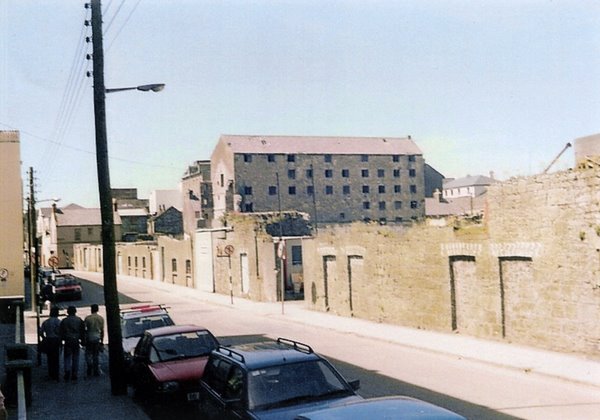Old Galway
Our Lady's Boys Club, A Galway Gem

This happy group of Boys Club lads was taken in the mid fifties and includes Paddy O’Connell, Dominick Curran, Seanie Flaherty, Joe Walsh, --- Harty, Tommy Gannon, Dessy Fitzpatrick, Tommy Gannon, Michael Burke, Tom Cunningham, Bartley Hynes, Tony Conboy (taking the shot), Sean McNamara, Gerry Ryan, Willie Golding, Colie Rushe, William McDonagh, Peter Folan, Leo Creane,Francis Walsh, Danny Collins, Jackie Molloy, Dominick Geary and Paddy McDonagh.The main objective of the Club (the oldest Boys Club in the country) when it was founded in 1940 was “To provide for the relief of poverty by serving homeless kids in need,
The Great Famine in Galway

Like most towns in Ireland, Galway was used to food shortages, they had occurred here in 1816, 1817, 1822, 1831, and in 1842 there were food riots in the city. Nobody, however, was prepared for what happened in 1845 when the potato crop failed. As winter approached, the situation did not seem any worse than usual, though people were concerned about food being exported from the docks while there was a shortage locally.As the full extent of the crop failure became evident,the workhouse became overcrowded, the Fever Hospital on Beggar’s Bridge (which got its name from inmates begging on the bridge)
Galway Minors, All Ireland Champions, 1970

Now that Alan Mulholland’s Under-21 team have kick started the Galway GAA season in such spectacular fashion, we thought to show you some champions of yesteryear, the county minor team who won the All Ireland in 1970.They are, back row; Mickey Rooney, Cortoon ; Alfie Marren, Kilkerrin/Clonberne ; Michael Meehan, Kilkerrin/Clonberne ; Sean Higgins, Kilkerrin/Clonberne ; Stephen Cloonan, Athenry ; Michael Geraghty, Glenamaddy ; Iomar Barrett,Mountbellew ;John Kemple, Tuam Stars.In front are John Tobin, Tuam Stars ;Tom Connor, Killanin ; Peter Silke, Dunmore McHales ; Joe Corcoran, St. Michaels, captain ; P.J.
Calling All Jes Past Pupils

The Jesuits first came to Galway in 1645 and settled in a 3-storey building on the site of the present ‘Four Corners’, thanks to the generosity of Edmund Kirwan, a wealthy Galway merchant. Most likely, it was in these premises that their school was conducted, against a background of wars and dissensions. Yet it flourished, in spite of all priests being banished from the city by the Cromwellians, and later the Williamites.The Jesuits came back in 1728, but their mission was withdrawn in 1768 due to a lack of manpower. They were invited back in 1859 by the bishop and set up a college in Eyre Square. The college’s present location on Sea Road dates from 1863.They had to
Merchant's Road, After the Fire

This photograph was taken in the late seventies, and shows how quickly streetscapes can change. Merchant’s Road was originally known as ‘Back Street’ because it was at the back of (outside) the old city walls. As the docks were developed, a lot of warehousing and industrial buildings were constructed around the area to facilitate companies who were importing and exporting from the port, and so Merchant’s Road came into being. It was a drab street, quite a bit of the area we see in the foreground was warehousing like the tall building we see in the centre of our picture.All of that was to drastically change on the morning of August 16th,1971 when a huge fire broke out and
Old Abbeygate Street

There is a real vintage feeling to this photograph of Abbeygate Street which dates from the 1970’s. The double yellow lines are about the only ‘modern’ thing about this image. The street has undergone many changes since.The house we see on the left was occupied by Mr. Kemple and his daughters.The house next door was occupied by the Heaney family and was described as “A large two-bay,three-storey house of cut limestone which dates from the early nineteenth century. The shopfront is simple though it has the letter H incised on the plaster brackets of the fascia.
Galway Textile Printers

Our photograph today, which is courtesy of Pat McPhilbin from Emmett Avenue in Mervue, shows a large factory building which was constructed by Sisks (with Jack Lillis in charge) on a site on Sandy Road in the early fifties. It was to house an industry called Galway Textile Printers which was known locally as ‘The Cotton Factory’, and even more colloquially as ‘The Cotton’. There already was a Hat Factory and a China Factory here, but GTP was the first major industry to come to Galway and quickly became one of the biggest employers in the west of Ireland. Some of those who worked there were specialists who were brought in to help set the factory up, but most employees were local.
Calling All Salerno Past Pupils

Bishop Browne invited the Sister of Jesus and Mary to open an National School in Salthill, and on May 1st 1952, Scoil Íde opened in what used to be a small hotel called Dalysfort House, with 43 pupils and 3 teachers. The numbers grew rapidly, so it was decided to knock the old hotel and build a new school. This was officially opened by the Minister for Education, Dr. Patrick Hillery in 1962.The population of Salthill was expanding rapidly, and the Sisters felt the need for a new girls secondary school, so that same year they started a ‘secondary top’,a first-year secondary school class which was housed in Scoil Íde. There were eight pupils in that class, Geraldine Kelleher,
